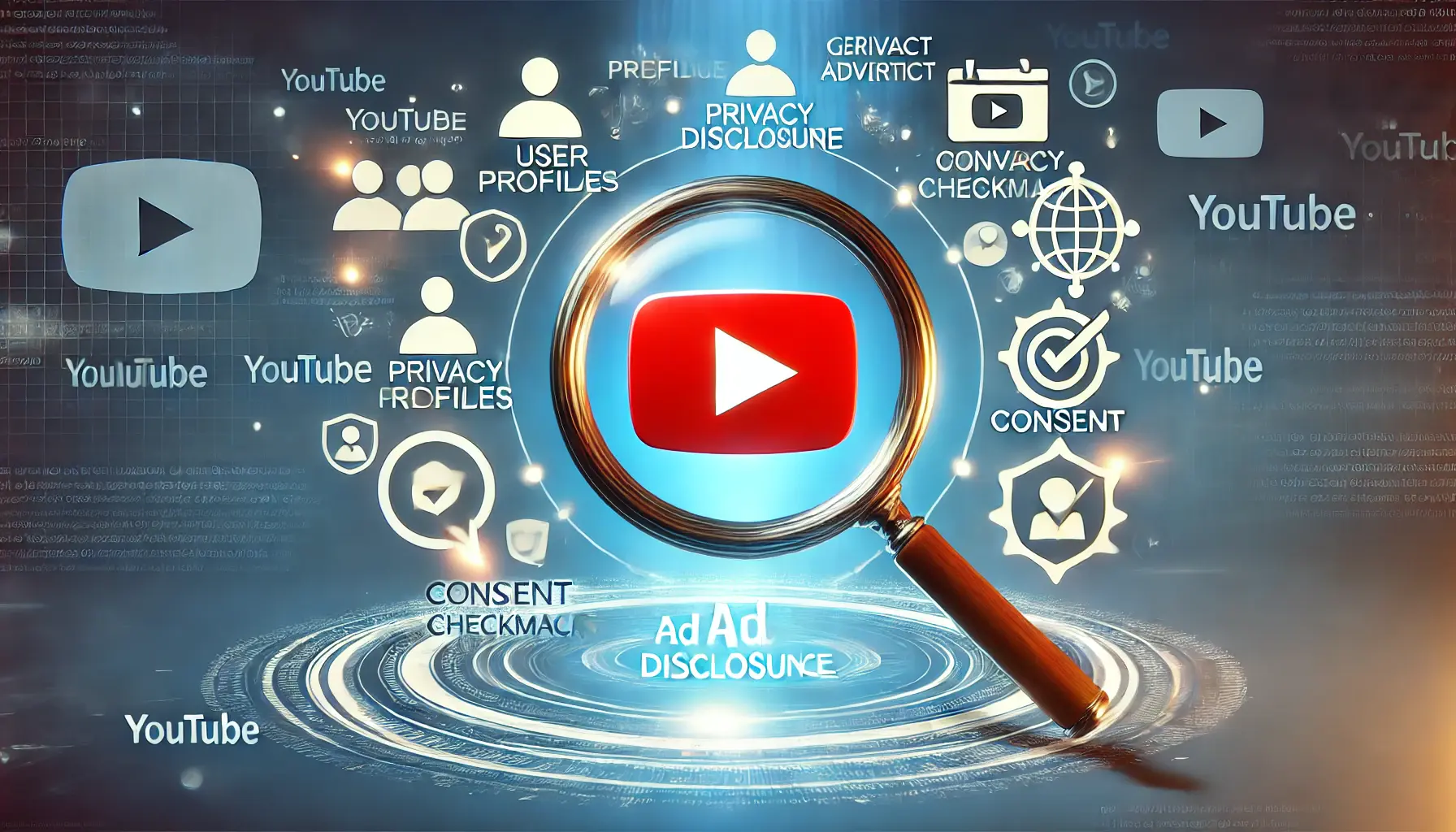Data privacy is one of the hot topics in today’s digital landscape, which remains a critical concern for consumers and businesses alike.
As advertisers, you want your campaigns to be truly effective but not at the expense of your audience’s trust.
YouTube is one of the biggest advertising platforms and offers unparalleled opportunities for businesses to reach their targeted audiences.
However, it comes with significant responsibilities related to user data privacy.
Navigating these complexities is important to ensure your campaigns are effective and compliant with evolving regulations.
The following article highlights some key considerations for maintaining data privacy in YouTube advertising.
We’ll uncover the best practices and strategies to ensure you’re not only reaching your audience effectively but also respecting their data privacy rights.
- Understanding Data Privacy in YouTube Advertising
- Key Regulations Influencing YouTube Ad Privacy
- Best Practices for Keeping Data Private in YouTube Ads
- Minimizing Data Privacy Risks in YouTube Advertising
- Future Trends in Data Privacy for YouTube Advertising
- Summary: Key Takeaways on Data Privacy in YouTube Advertising
- Frequently Asked Questions about Data Privacy in YouTube Advertising
Understanding Data Privacy in YouTube Advertising
Before diving into specific strategies, it’s important to understand what data privacy means in the context of YouTube advertising.
At its core, data privacy refers to the responsible handling of user information—ensuring that personal data is collected, stored, and used in ways that are transparent and ethical.

Visual representation of data privacy showcasing secure data handling and ethical practices.
What is Data Privacy and Why Does it Matter?
Data privacy is more than just a buzzword—it’s a fundamental right of every user.
When running YouTube ads, your audience entrusts you with information such as viewing habits, click patterns, or demographic details.
Any misuse or mishandling of this data can lead to a loss of trust, regulatory fines, and reputational damage.
Protecting data privacy ensures that your advertising practices align with both ethical standards and legal requirements.

Illustration of how YouTube gathers user data for advertising purposes.
How YouTube Collects User Data for Ads
YouTube leverages a wealth of user data to deliver personalized ads.
This includes search history, watch history, and interactions across the platform.
These insights are used to segment audiences and improve ad targeting, providing advertisers like you with tools to maximize campaign performance.
However, this also raises questions about how much information is being gathered and whether it’s being used responsibly.
- Search History: YouTube tracks what users search for, helping advertisers understand intent and preferences.
- Watch Behavior: Viewing patterns give insights into interests, enabling more accurate ad placements.
- Engagement Metrics: Likes, comments, and shares contribute to audience profiling for ad optimization.
While this data collection benefits advertisers, it’s essential to handle it carefully to avoid breaches of trust.

Visual representation of the balance between digital advertising and data privacy regulations.
Regulations Impacting YouTube Ads and Data Privacy
Various laws and regulations govern how data is collected and used in advertising.
For YouTube, compliance with global regulations such as GDPRGeneral Data Protection Regulation, a comprehensive data protection law enacted by the European Union to ensure data privacy for individuals. (General Data Protection Regulation) and CCPACalifornia Consumer Privacy Act, a data privacy law that grants California residents rights over their personal information. (California Consumer Privacy Act) is non-negotiable.
These frameworks ensure that users have control over their data and require advertisers to be transparent about their practices.
Understanding these regulations is critical to creating campaigns that respect privacy while achieving desired results.
Ignorance of the law is not a defense—so staying informed and proactive is key.

Illustration emphasizing the importance of user consent in data collection processes.
The Role of Consent in Data Collection
Consent plays a pivotal role in data privacy.
YouTube ensures that users agree to its terms and data collection practices.
However, as an advertiser, it’s your responsibility to align your campaigns with these principles.
Ensuring that your ads respect user preferences and provide clear opt-out options can reinforce trust and compliance.
By understanding the basics of data privacy in YouTube advertising, you set the stage for creating ethical, successful campaigns.
In the next section, we’ll explore the regulatory landscape and its influence on data privacy for advertisers.
Data privacy is a fundamental right of every user, and advertisers must handle user data responsibly to maintain trust and comply with regulations.

Representation of global regulations influencing data privacy in YouTube advertising.
Key Regulations Influencing YouTube Ad Privacy
In the realm of YouTube advertising, understanding and complying with data privacy regulations is crucial.
These laws are designed to protect user information and ensure that businesses handle data responsibly.
Let’s delve into some of the key regulations that impact YouTube ad privacy.

Illustration of GDPR’s impact on data privacy for YouTube advertisers.
GDPR and Its Implications for YouTube Advertisers
The General Data Protection Regulation (GDPR) is a comprehensive data protection law enacted by the European Union.
It mandates that businesses obtain explicit consent from users before collecting or processing their personal data.
For YouTube advertisers, this means:
- Obtaining Consent: Ensure that you have clear consent from users within the EU before collecting their data for ad targeting purposes.
- Data Minimization: Collect only the data necessary for your advertising objectives to comply with GDPR’s data minimization principle.
- Transparency: Clearly inform users about how their data will be used in your advertising campaigns.
Non-compliance with GDPR can result in substantial fines, making it imperative for advertisers to adhere strictly to its provisions.

Visual representation of the California Consumer Privacy Act and its focus on user data protection.
CCPA: Protecting California Consumer Privacy
The California Consumer Privacy Act (CCPA) grants California residents rights over their personal information, including the right to know what data is being collected and the ability to opt out of its sale.
For YouTube advertisers targeting audiences in California, this entails:
- Disclosure: Inform consumers about the categories of personal data being collected and the purposes for which it is used.
- Opt-Out Mechanism: Provide a clear and accessible way for consumers to opt out of the sale of their personal information.
- Data Access and Deletion: Honor requests from consumers to access or delete their personal data.
Adhering to CCPA not only ensures compliance but also builds trust with your audience by respecting their data privacy rights.

Illustration of COPPA’s role in protecting children’s privacy in YouTube advertising.
How COPPA Impacts YouTube Advertisements
The Children’s Online Privacy Protection Act (COPPAChildren's Online Privacy Protection Act, a U.S. federal law that imposes requirements on websites and online services directed at children under 13 years of age.) is a U.S.
federal law that imposes certain requirements on websites and online services directed at children under 13 years of age.
For YouTube advertisers, COPPA compliance involves:
- Age Screening: Implement measures to avoid collecting personal information from children under 13 without verifiable parental consent.
- Content Targeting: Ensure that ads are not inappropriately targeted at children, especially when involving data collection.
- Privacy Policies: Clearly outline your data collection and use practices concerning children’s data.
Violations of COPPA can lead to significant penalties, so it’s essential to ensure that your advertising practices are in full compliance with this law.

Representation of emerging data privacy laws and the challenges of global compliance.
Emerging Privacy Laws and Global Compliance Challenges
Beyond GDPR, CCPA, and COPPA, new data privacy laws are emerging worldwide, each with its own set of requirements.
For instance, the American Privacy Rights Act (APRAAmerican Privacy Rights Act, a proposed U.S. law aimed at standardizing state privacy laws and providing clearer data privacy frameworks.) is poised to be a game-changer for data privacy in the U.S.
in 2025.
It aims to standardize numerous state laws and provide businesses with a clearer roadmap for compliance.
To manage these challenges effectively, YouTube advertisers should:
- Stay Informed: Keep up to date with the latest and constantly changing data privacy laws in each region.
- Develop Flexible Strategies: Create compliance strategies in data handling to meet varied legal requirements.
- Implement Comprehensive Governance: Put in place a data governance framework to oversee compliance across multiple jurisdictions.
By proactively addressing these challenges, YouTube advertisers can reduce legal risks and maintain the trust of their global audience.
Understanding and adhering to these regulations is not only a legal obligation but also a cornerstone of ethical advertising.
In the next section, we will explore the best practices for maintaining data privacy in your YouTube ad campaigns.
Regulations like GDPR, CCPA, and COPPA define how advertisers must handle data, ensuring transparency and control for users.

Illustration of best practices for ensuring data privacy in YouTube advertising.
Best Practices for Keeping Data Private in YouTube Ads
Keeping data private in your YouTube advertising is not only a legal obligation but also a cornerstone in building your audience’s trust.
The following good practices will enable you to run effective ads while keeping users’ information safe:

Visual representation of privacy-compliant targeting strategies for YouTube ads.
Configuring Targeting Strategies That Comply With Privacy
Developing targeting strategies that are compliant with data privacy regulations is important.
Consider the following steps:
- Limit Data Collection: Collect only the data necessary for your advertising objectives, adhering to the principle of data minimization.
- Use Aggregated Data: Utilize aggregated and anonymized data to target audiences without compromising individual privacy.
- Obtain Explicit Consent: Ensure that users have provided clear consent for data collection and ad targeting, especially in regions governed by strict privacy laws.
By focusing on these strategies, you can effectively reach your target audience while respecting their privacy.

Illustration of transparency with consumers through clear ad disclosures.
Transparency with Consumers Through Ad Disclosures
Being transparent about your data practices fosters trust and compliance.
Implement the following measures:
- Clear Privacy Policies: Provide easily accessible and understandable privacy policies that explain how user data is collected and used.
- Ad Disclosures: Clearly disclose when content is sponsored or when ads are personalized based on user data.
- Communication Channels: Offer channels for users to ask questions or express concerns about their data privacy.
Transparency not only complies with legal standards but also enhances your brand’s reputation.

Illustration of secure data retention and the use of aggregated insights for privacy compliance.
Limiting Data Retention and Using Aggregated Insights
Managing the amount of time you retain user data and how you utilize it is crucial for privacy compliance:
- Data Retention Policies: Establish and enforce policies that define how long user data is stored, ensuring it is not kept longer than necessary.
- Regular Data Audits: Conduct periodic audits to ensure compliance with your data retention policies and identify any unnecessary data that can be deleted.
- Aggregated Insights: Use aggregated data to analyze campaign performance, which reduces the risk of exposing individual user information.
These practices help in minimizing privacy risks associated with data storage and usage.

Illustration of privacy compliance in third-party tools through interconnected secure systems.
Ensuring Third-Party Tools Are Privacy Compliant
When utilizing third-party tools for your YouTube advertising campaigns, it’s vital to ensure they adhere to data privacy standards:
- Vendor Assessments: Evaluate third-party vendors for their data privacy practices and compliance with relevant regulations.
- Data Processing Agreements: Establish clear agreements that outline data handling procedures and responsibilities.
- Continuous Monitoring: Regularly monitor and review third-party practices to ensure ongoing compliance.
Partnering with compliant third-party tools safeguards your campaigns from potential privacy breaches.

Illustration of periodic privacy audits ensuring compliance in ad campaigns.
Periodic Privacy Audits for Ad Campaigns
Regularly auditing your ad campaigns ensures they remain compliant with data privacy laws:
- Scheduled Reviews: Conduct audits at regular intervals to assess compliance with data privacy policies and regulations.
- Documentation: Maintain thorough records of data collection, usage, and consent to demonstrate compliance.
- Training and Updates: Provide ongoing training for your team on data privacy best practices and update procedures as regulations evolve.
Periodic audits help in identifying and mitigating potential privacy issues before they escalate.
Implementing these best practices in your YouTube advertising campaigns not only ensures compliance with data privacy regulations but also builds trust with your audience, leading to more effective and ethical advertising outcomes.
Implementing data privacy best practices, such as limiting data collection and ensuring transparency, is crucial to maintaining audience trust and compliance.

Illustration of strategies to minimize data privacy risks in YouTube advertising.
Minimizing Data Privacy Risks in YouTube Advertising
In this ever-changing digital marketing landscape, data privacy protection for your YouTube advertising is crucial.
Understanding potential risks and implementing effective mitigation strategies not only ensures compliance with regulations but also fosters trust with your audience.

Illustration of common data privacy risks in YouTube ads.
Identifying Common Data Privacy Risks in YouTube Ads
Recognizing the prevalent data privacy risks associated with YouTube advertising is the first step toward effective mitigation.
Common risks include:
- Unauthorized Data Collection: Gathering user data without explicit consent can lead to significant legal repercussions.
- Inadequate Data Security: Failing to protect collected data increases the risk of breaches and unauthorized access.
- Non-Compliance with Regulations: Ignoring data privacy laws such as GDPR or CCPA can result in hefty fines and damage to your brand’s reputation.
Understanding these risks is essential for developing robust data privacy strategies.

Illustration of robust data security measures for protecting sensitive information.
Implementing Robust Data Security Measures
To mitigate data privacy risks, it’s crucial to establish strong data security protocols:
- Data Encryption: Employ encryption methods to protect data both in transit and at rest, ensuring that even if data is intercepted, it remains unreadable.
- Access Controls: Restrict data access to authorized personnel only, minimizing the chances of internal data misuse.
- Regular Security Audits: Conduct frequent security assessments to identify and address vulnerabilities promptly.
Implementing these measures helps maintain the integrity and confidentiality of user data.

Illustration of compliance with data privacy regulations in a global context.
Ensuring Compliance with Data Privacy Regulations
Adherence to data privacy laws is non-negotiable.
To ensure compliance:
- Stay Informed: Keep abreast of the latest data privacy regulations relevant to your target audience’s regions.
- Legal Consultation: Engage with legal experts to understand and interpret complex data privacy laws accurately.
- Documentation: Maintain comprehensive records of data collection and processing activities to demonstrate compliance when required.
Proactive compliance not only avoids legal penalties but also enhances your brand’s credibility.

Illustration of team education on data privacy best practices.
Educating Your Team on Data Privacy Best Practices
Your team’s awareness and understanding of data privacy are vital.
Build a culture of privacy by:
- Training Programs: Offer periodic training programs to update your staff with the latest best practices in data privacy and changes in regulations.
- Clear Policies: Establish clear policies on data privacy that define acceptable practices and procedures.
- Encouraging Vigilance: Create an environment that encourages team members to report any probable data privacy issues without hesitation.
An informed team is your first line of defense against risks in data privacy.

Illustration of periodic review and update of privacy policies for compliance.
Periodic Review and Update of Privacy Policies
Data privacy is an evolving field.
Keep your privacy policies effective by:
- Periodic Reviews: Regularly review policies to ensure they align with current legislation and industry standards.
- Stakeholder Feedback: Gather feedback from stakeholders to identify blind spots in your data privacy practices.
- Transparent Communication: Clearly communicate policy changes to your audience, reinforcing your commitment to protecting their privacy.
Continuous improvement of your privacy policies helps address new challenges and maintain user trust.
By being proactive, recognizing risks, and following these strategies to mitigate them, you can confidently navigate the complexities of data privacy in YouTube advertising and run effective ad campaigns.
Identifying and addressing common data privacy risks such as unauthorized data collection and inadequate security measures is essential for protecting user privacy.

Illustration of future trends in data privacy for YouTube advertising.
Future Trends in Data Privacy for YouTube Advertising
As the digital landscape evolves, data privacy remains a pivotal concern for YouTube advertisers.
Staying ahead of emerging trends is essential to maintain compliance and foster trust with your audience.
Let’s explore the key developments shaping the future of data privacy in YouTube advertising.

Illustration of the shift towards first-party data strategies in digital advertising.
Shift Towards First-Party Data Strategies
With the decline of third-party cookies, advertisers are increasingly relying on first-party data—information collected directly from their audiences.
This approach offers several advantages:
- Enhanced User Trust: Collecting data transparently from your audience builds trust and aligns with privacy regulations.
- Improved Data Accuracy: First-party data is often more accurate and relevant, leading to better-targeted advertising campaigns.
- Regulatory Compliance: Utilizing first-party data helps ensure adherence to data privacy laws, reducing legal risks.
Implementing robust first-party data strategies will be crucial for effective and compliant YouTube advertising in the future.

Illustration of the adoption of Privacy-Enhancing Technologies (PETs) in digital advertising.
Adoption of Privacy-Enhancing Technologies (PETs)
Privacy-Enhancing Technologies are becoming integral in safeguarding user data while enabling valuable insights for advertisers.
Key PETs include:
- Data Clean Rooms: Secure environments where aggregated data can be analyzed without exposing personal information.
- Federated Learning: A machine learning approach that trains algorithms across decentralized devices, keeping data localized and private.
- Differential Privacy: Techniques that add statistical noise to data analyses, protecting individual identities while providing accurate insights.
Integrating these technologies into your advertising strategy can help balance data utility with user privacy.

Illustration of increased regulatory scrutiny and the need for global compliance in digital advertising.
Increased Regulatory Scrutiny and Global Compliance
Data privacy regulations are becoming more stringent worldwide, with new laws emerging and existing ones being reinforced.
Advertisers must:
- Stay Informed: Keep abreast of global data privacy laws and ensure your practices comply with regional requirements.
- Implement Flexible Compliance Strategies: Develop adaptable data handling procedures to meet diverse legal standards across different markets.
- Engage in Continuous Monitoring: Regularly review and update your data privacy practices to align with evolving regulations.
Proactive compliance will be essential to navigate the complex global regulatory environment.

Illustration of user empowerment and transparency in data privacy practices.
Emphasis on User Empowerment and Transparency
Users are increasingly aware of their data privacy rights and expect transparency from advertisers.
To meet these expectations:
- Provide Clear Privacy Policies: Make information about data collection and usage practices accessible and understandable to users.
- Enable User Control: Give users control over their data preferences, including the ability to opt out of data collection or personalized advertising.
- Communicate Openly: Maintain open lines of communication to respond to user concerns and demonstrate your commitment to data privacy.
Empowering users and being transparent about data practices will build trust and engagement with your brand.

Illustration of integrating artificial intelligence into ethical considerations.
Integrating Artificial Intelligence into Ethical Considerations
Artificial Intelligence (AI) is transforming advertising, offering advanced targeting and personalization capabilities.
However, ethical considerations are crucial:
- Ensure Data Privacy: Use AI in ways that protect user data and comply with privacy regulations.
- Be Transparent: Clearly communicate how AI influences ad content and user experiences.
- Address Bias and Fairness: Implement measures to prevent algorithmic biases that could lead to unfair targeting or exclusion.
Balancing AI innovation with responsible data handling will be critical for future advertising success.
By staying updated with these emerging trends, you can confidently navigate the future of data privacy in YouTube advertising, ensuring compliance and maintaining long-term trust with your audience.
Staying ahead of emerging data privacy trends, such as first-party data strategies and privacy-enhancing technologies, will be critical for future-proofing your campaigns.

Illustration summarizing key takeaways on data privacy in YouTube advertising.
Summary: Key Takeaways on Data Privacy in YouTube Advertising
As digital advertising continues to grow, ensuring data privacy in YouTube ads has become more important than ever.
In this article, we discussed essential considerations, practical strategies, and emerging trends to help advertisers navigate this complex landscape.
By prioritizing data privacy, you not only comply with regulations but also build long-term trust with your audience, leading to more effective and ethical campaigns.

Illustration of the core principles of data privacy in YouTube advertising.
Core Principles of Data Privacy in YouTube Ads
Understanding the foundations of data privacy is crucial for advertisers.
It involves responsibly collecting, storing, and using user information while maintaining transparency and ethical practices.
This ensures compliance with regulations such as GDPR, CCPA, and COPPA while reinforcing user trust.

Illustration of practical strategies for advertisers ensuring data privacy.
Practical Strategies for Advertisers
Throughout the article, we highlighted several best practices to safeguard data privacy:
- Adopting privacy-compliant targeting strategies that emphasize consent and data minimization.
- Ensuring transparency with users by providing clear privacy policies and ad disclosures.
- Limiting data retention and using aggregated insights to reduce privacy risks.
- Evaluating and partnering with privacy-compliant third-party tools.
- Conducting regular privacy audits to stay ahead of potential risks and maintain compliance.

Illustration of emerging trends shaping the future of data privacy in YouTube advertising.
Emerging Trends Shaping the Future
The future of data privacy in YouTube advertising is shaped by innovations and evolving regulations.
Key trends include:
- A shift toward first-party data strategies as third-party cookies become obsolete.
- Integration of Privacy-Enhancing Technologies (PETs) like data clean rooms and federated learning.
- Heightened regulatory scrutiny and the need for global compliance frameworks.
- Empowering users with greater control over their data and fostering transparency.
- Leveraging Artificial Intelligence responsibly, balancing innovation with ethical considerations.

Illustration of ‘The Road Ahead’ in data privacy for YouTube advertising.
The Road Ahead
To thrive in the ever-evolving digital landscape, advertisers must stay informed and proactive in addressing data privacy challenges.
Embracing the practices and trends discussed in this article will ensure your campaigns are effective, compliant, and respectful of user rights.
This approach fosters sustainability and builds a credible, long-term relationship with your audience, driving lasting success.
By prioritizing data privacy in YouTube ads, advertisers not only comply with regulations but also build long-term trust with their audience, leading to more effective campaigns.

Illustration representing frequently asked questions about data privacy in YouTube advertising.
Your campaigns can be managed by an agency specialized in Google Ads, check out our service page.
Frequently Asked Questions about Data Privacy in YouTube Advertising
YouTube collects data such as watch history, search queries, device information, and location to personalize ads and enhance user experience.
Advertisers should obtain explicit user consent, adhere to data minimization principles, and stay updated with relevant regulations like GDPR and CCPA.
Privacy-Enhancing Technologies include tools and techniques such as data clean rooms and differential privacyA privacy-preserving method of adding statistical noise to data analyses, protecting individual identities while allowing accurate insights. methods that protect user data while enabling effective ad targeting.
First-party data enhances user trust and compliance as it involves collecting data directly from users with their consent, fostering transparency and accuracy.












